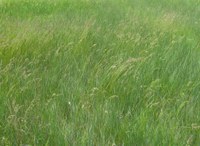Early Spring Means Cutting Hay Early
(Click the image below to view a high-resolution image that can be downloaded)
Now is the time to start cutting hay, North Dakota State University livestock and rangeland specialists advise.
Although hay usually isn’t harvested for the first time for another two weeks, weather conditions this spring have led to alfalfa and grasses maturing about 10 days earlier than normal, according to Kevin Sedivec, the NDSU Extension Service’s rangeland management specialist.
The lack of snow during the winter allowed the soil to warm sooner and the grasses and alfalfa to start growing earlier. However, the below-normal snowfall meant less water was available for the grasses and alfalfa, and spring rains didn’t fall at the right time to help the hay crop grow. Thus, while the warm temperatures were encouraging growth, the lack of water stalled the crops in some areas.
Harvesting alfalfa and the grasses now will result in hay of the same quality as it was in the first cutting last year, Sedivec says.
“Cutting now will set the stage for a good second cutting with adequate rains,” he adds. “If you don’t cut now, then the second cutting may not yield as well as expected. And if you cut now, you’ll be able to do a third cut later in the season in eastern portions of the state.”
He also notes that total tonnage from the first cut will be lower than last year, but that should be offset if producers take a second cutting of a hay crop such as alfalfa.
“Obviously, ranchers are looking for the best combinations of quality and quantity in their forage, and sometimes more quantity for wintering cows,” says Karl Hoppe, an area Extension livestock specialist based at NDSU’s Carrington Research Extension Center. “Some ranchers will tend to cut hay late to get quantity without sacrificing too much quality (protein and energy). For this year, cut by the plant’s maturity and not the calendar date or you will get poorer quality feed than expected. And then look for regrowth and a second cutting.”
While winter kill always is possible in alfalfa, poorer stands this year probably aren’t from winter kill, Sedivec says. More likely, they are the result of poor growth due to a lack of water and too much heat early in the growing season, followed by a cool May.
If fertility is an issue, one option is to spread manure on the alfalfa or grass hay field immediately after the first cutting is harvested and bales are removed, says Ron Wiederholt, nutrient management specialist at the Carrington Research Extension Center.
“The key to success is to apply a thin layer of composted or broken-down manure that won’t leave any clumps,” he says.
Hoppe suggests testing hay for forage quality after the hay is baled to help plan feed needs for wintering cows. Contact your local Extension agent for information on how to sample hay for testing and where to send the samples, as well as help in understanding what the results mean.
“You can match the hay to the cows’ needs if you know what you have,” Hoppe says.
NDSU Agriculture Communication - June 8, 2012
| Source: | Karl Hoppe, (701) 652-2951, karl.hoppe@ndsu.edu |
|---|---|
| Source: | Kevin Sedivec, (701) 231-7647, kevin.sedivec@ndsu.edu |
| Source: | Ron Wiederholt, (701) 652-2951, ron.wiederholt@ndsu.edu |
| Editor: | Ellen Crawford, (701) 231-5391, ellen.crawford@ndsu.edu |


